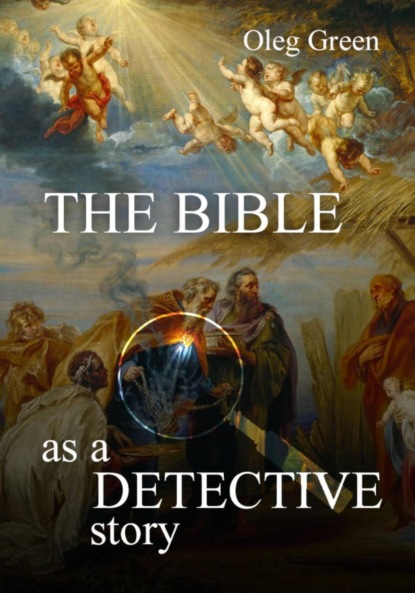- -
- 100%
- +

Preface
"It is impossible for there to be more or fewer Gospels than there are. For since there are four cardinal points in the world in which we live, and four cardinal winds, and since the Church is scattered throughout the earth, and the pillar and foundation of the Church is the Gospel and the Spirit of life, it is fitting that she have four pillars." (Hieromortyr Irenaeus of Lyons)
When we read the Gospels, we must keep in mind that we have before us something like a layer cake:
The very bottom, first layer is the real historical events reflected (exactly like that) in them.
Which "peep through" the second layer, which is the Gospels themselves (the canonical and the surviving apocryphal texts, as well as other New Testament texts). For example, Jesus was indeed a Galilean by birth. And he was undoubtedly crucified during the reign of Pontius Pilate. And so on. Unfortunately, overall, this second layer is, to put it mildly, not very reliable.
The third layer consists of later edits ‑to the insertion, primarily from the Byzantine era. These were literally stuffed, like raisins into a bun, by the pious bishops of that time into what was supposedly sacred Scripture (let's be kind to them, they were believers, after all). Therefore, Jesus, for example, undoubtedly foretold the imminent coming of the "Son of Man" as the long-awaited Jewish Messiah, but he certainly did not send his disciples "to make disciples of all nations, baptizing them in the name of the Father and the Son and the Holy Spirit."
The fourth layer is—at least for the Russian-speaking reader—the Synodal Translation, completed in the 19th ‑century and still circulated by the Russian Orthodox Church. I will try to speak about it as carefully as possible in what follows. Otherwise, if I were to speak frankly, this book would not have passed the publisher's censorship.
And finally, the fifth layer is what is not directly in the Gospels themselves, but what the reader usually brings into them without noticing it.
In doing so, we commit two very natural, yet very serious, mistakes. Firstly ‑—and this is especially true for believers—as we read, we often unconsciously introduce our own preconceived notions. For example, at the very beginning of the Gospel of Mark, we read that someone named Jesus came to the Jordan to be baptized by John. And of course, we ‑know that it was God who came to John, born a man from the Virgin Mary! As a result, instead of understanding the author's ideas, we simply project our own familiar template onto the text.
Secondly ‑, we—again, ignoring the author's thought process and without even thinking about it—introduce into his text what is written in another text. After all, all four Gospels recount the same events, don't they? For example, we read in Matthew that after the betrothal of Joseph and Mary, she "turned out" to be pregnant by the Holy Spirit. How did this "turn out"? What could that mean? Oh yes, we "know" how—after all, Luke describes the Annunciation scene, where an angel comes to Mary's house with a prophecy! Or, another example: what was the first miracle Jesus performed? Of course, we "know"—he turned water into wine at the wedding in Cana of Galilee. True? Or not? Or was this written by the author of the Gospel of John at the end of the first century, and only by him? And not in the other evangelists?
And of course, believers, Christians, make a third, most serious mistake. Being a priori convinced of the "divine inspiration" of the Gospels, they are unable, purely psychologically, through a subconscious blockade of thought, to question their authenticity. In this case, the result can sometimes become, pardon me, comical. For example, someone reads with their own eyes Jesus's prophecy that not all those standing near him will die before they see "the kingdom of God come with power"—but the believing reader simply cannot accept that Jesus could be mistaken. He is God, and the Gospels are divinely inspired! And so… they begin to resort to all sorts of unthinkable and sophisticated conjectures, so beloved of theologians in such cases (on the other hand, what else can they do?). I urge the reader not to succumb to such weaknesses.
Typically, believers (Christians) perceive the Four Gospels as if four witnesses to certain events had described them, each as best they could and as best they could remember. In such a case, if we were talking about a real event and real witnesses, we would see the following picture: the witnesses' testimonies generally agree, but may differ slightly in detail (one remembered one detail, another another, someone else ‑may have made a slight mistake in their recollection—this is normal), and may even contradict each other in minor details. And, of course, each witness's account will have a distinctive style and language, because each person expresses their thoughts in a way that is unique to them. So, believers, reading the Gospels, perceive them in much the same way: as four authorial accounts by four independent witnesses, or, at least, as records from the words of four witnesses, participants in the events.
With the important addition noted above, believers, as stated above, consider the Bible to be a divinely inspired text. Therefore, despite the differences in the literary styles of various authors and the differences in the details of the descriptions, the text of the Gospels is, overall, truth. Or rather: Truth, with a capital T.
Figuratively speaking (I recall how I myself perceived the Gospels earlier), the Four Gospels are like a painting, simultaneously painted by four artists with four brushes, guided by the Holy Spirit. Some details were painted by one, some by another, and others they painted together, each introducing slight artistic differences—into the overall picture, I repeat. In other words, the Gospels are perceived as a single book. It's as if "God commissioned four authors to write a Gospel each, to the best of their ability, their desire, and their skill, while at the same time being guided by the Holy Spirit and striving to convey a sincere and honest account of the true events, with God accompanying them in this endeavor."
In reality—and I hope this will become clear below—the situation here is quite different. The Gospel of Mark is the original narrative (although biblical scholars are convinced that it is partly based on a certain lost text, "Q," and I would add that it also draws a bit on the Epistles of the Apostle Paul). Then the author of the Gospel of Matthew rewrites it, adding to and changing it as he sees fit. Then the author of the Gospel of Luke rewrites Mark's text, also "correcting" it, while also using Matthew's text *—preserving the latter's meaning but radically altering its narrative outline. And finally, the author of the Gospel of John, the latest (about 70 ‑years after the Crucifixion and almost a century after the Birth of Christ), takes one or more of these texts and, no longer rewrites them, creates a completely original work. In all four cases, the authors draw on the ideas about Jesus that were accepted in their time and within the religious movement to which they belonged. Thus, the Gospels consistently reveal how these ideas changed over time.
* – the fact that Luke relied not only on Mark's text but also on Matthew's is an important point, as the accepted view (including among professional biblical scholars, as far as the author knows) is otherwise. Further in the text, you will see the justification for this thesis.
Christmas
Chronologically, the earliest, as already stated, is the Gospel of Mark. For me, this isn't a matter of formal historical dating, but the result of a study of the four Gospels. This Gospel is placed second in the Bible after Matthew, and for an obvious reason: Mark doesn't yet have an account of Jesus's origin. Therefore, the compilers of the Biblical canon placed Matthew, who does have one, first. From here on, we will examine the Gospels in chronological order: Mark, Matthew, Luke, and John.
*******
So,
Gospel of Mark
“The beginning of the gospel of Jesus Christ, the Son of God; as it is written in the prophets: ‘Behold, I send my messenger before your face, who will prepare your way before you.’ The voice of one crying in the wilderness: ‘Prepare the way of the Lord, make his paths straight.’ John came baptizing in the wilderness and preaching the baptism of repentance for the remission of sins. And all the country of Judea and those from Jerusalem went out to him, and they were all baptized by him in the river Jordan, confessing their sins. Now John wore a garment of camel’s hair and a leather girdle around his loins, and he ate locusts and wild honey. And he preached, saying, ‘One mightier than I comes after me, whose sandal latchet I am not worthy to stoop down and unloose. I have baptized you with water, but He will baptize you with the Holy Spirit.’ And it came to pass in those days, that Jesus came from Nazareth of Galilee, and was baptized by John in the Jordan. And as he came up out of the water, immediately he saw the heavens opened, and the Spirit like a dove descending upon him. And a voice came from heaven, saying, You are my beloved Son, in whom I am well pleased. Immediately afterward the Spirit driveth him into the wilderness. And he was there in the wilderness forty days, tempted of Satan. And he was with the wild beasts: and angels ministered unto him. Now after John was put in prison, Jesus came into Galilee, preaching the gospel of the kingdom of God, and saying, The time is fulfilled, and the kingdom of God is at hand: repent ye, and believe the gospel. (Mark 1:1-15 ‑)
(The story then continues with Jesus calling his first disciples: Simon, Andrew, James and John, and then he begins to preach.)
Here we see several extremely important points from the author:
First ‑, and this is striking: Mark says nothing about Jesus's origins. Notice that he briefly but succinctly introduces John to the reader. But how does he introduce Jesus? He calls him "the Son of God" (that's right, "son" with a small "s"), but that's essentially just the title of the work. And then? What about his origins? Today, we're accustomed to the idea that Jesus is literally the Son of God—God the Son—and that he was born of the Holy Spirit to a virgin named Mary. We're ‑accustomed, but in his time, this sounded completely fantastical, even absurd ("to the Jews a stumbling block, and to the Greeks foolishness"—Apostle Paul). And not a word about this crucial circumstance?! Yes. John is briefly introduced, but Jesus is not? Yes.
Next. What does the "voice from heaven" say? Notice—it doesn't announce to those around him that Jesus is His (obviously, the author means God's) Son. No. The voice is telling Jesus this! Yes, obviously (since John saw the dove), we should understand the author to have also heard the voice from heaven. But the voice is addressed to Jesus.
Once again, this is important: the voice from heaven doesn't inform John that "this is my son," but Jesus that "you are my son!" Even if, according to the author, John also hears this message, the voice is addressed to Jesus. You must admit, in our usual interpretation, Jesus knew from infancy that he was God. And here God informs him that (obviously, "from now on"—from the moment of his baptism) this man is his son.
And thirdly: after this—that is, after Jesus is called "son" by God—"the Spirit leads him into the wilderness" (in the original, "And immediately the Spirit casts him out into the wilderness"). There Jesus is tempted by Satan—that is, essentially, undergoes a test.
What, apparently ‑, is the point here? It's that ideas about who Jesus was began to develop practically from apostolic times, and continued to evolve (including competing interpretations) for several centuries. One of the earliest interpretations (the Gospel of Mark is the earliest of all) was that Jesus was a man, once chosen by God and, through the rite of baptism (immersion in and emergence from water), adopted by Him. Adoption here should be understood in the most literal sense—in the same sense in which Joseph adopted Jesus after his birth. Cultural background must also be taken into account: the author of the Gospel of Mark was most likely Roman by culture (the author of the Gospel of Matthew was certainly Roman by culture, unlike Luke, who was Jewish, as discussed below). In Roman culture, it was common for an adult to be adopted by an older adult, and being adopted was considered higher and more honorable (!) than being a biological son. A biological son is a natural born son, but being chosen as a son was a greater honor.
And one more thing. What does the dove have to do with this? Why a dove? For comparison, in Acts (more on that later), tongues of fire descend upon the apostles at Pentecost. Today, the dove is a symbol of peace (as opposed to war). However, what did this mean in the cultural context of that time? That God grants people peace instead of war? But, firstly ‑, Jesus said the opposite: " I did not come to bring you peace, but a sword" (though this is in Matthew, not Mark). And secondly ‑, a dove descends upon Jesus.
The author found two possible interpretations, let's call them the classic and the conspiracy theorists. The classic interpretation, I quote Wikipedia:
"The Jews sacrificed doves in the Temple for the purpose of purification. It was the only bird available for such a procedure. The dove was also considered a symbol of Israel."
This is a very good interpretation, in my opinion – in this case, the author shows that Jesus is about to become a sacrifice of purification (as if atonement) for the people of Israel.
As for the conspiracy theories, here's a composite (from ru.wikipedia.org and ru.ruwiki.ru) neural network response. I don't see any point in tweaking it:
In Sumero ‑-Akkadian mythology, the dove personified Ishtar, the goddess of love and fertility. This is evidenced by archaeological terracotta figurines of the goddess, on whose raised hand the bird was often depicted.
In Ancient Greece, the dove was an attribute of the goddess Aphrodite, and also one of the attributes of the ancient Greek hero Hercules.
In Ancient Rome, the doves of Venus, who made their nest in the overturned helmet of Mars, were considered a symbol of peace.
By the way, Ishtar, Aphrodite, and Venus are names of the same goddess in different cultures. It remains to be added that, in my opinion, these interpretations do not contradict each other, but rather complement each other.
And then, as we see, Jesus faces a forty-day ordeal in the desert. This, of course, is a clear allusion to the forty-year wilderness wandering of the people of Israel. Jesus departs from the desert to preach in Galilee after "John was betrayed"—this is likely an allusion to how Joshua set out to conquer the Promised Land after the death of Moses at the end of the forty-year wandering (note that John also preached in the desert). Jesus, however, was not in the desert—so he, as if symbolizing the second Joshua (who "gave" the Jews the Promised Land, and Jesus brought the Kingdom of God), also spends forty days in the desert.
Finally, I'll reiterate: Jesus's origins and family are not described at all at the beginning of the Gospel. Although, in theory, this is the genre of biography, and it should have begun there (not to mention the immaculate conception by the Holy Spirit!). It would be a different matter if the author's focus was not on Jesus's origins, but on his recognition by John, his following John (as the forerunner, "one who prepared the way"), and his adoption by God.
By the way, what is the significance of John's role as a forerunner? What kind of role is this? What exactly did John do to "prepare the way"? This, in my opinion, is a symbolic allusion—just as Moses "prepared the way" for Joshua to the Promised Land, so John symbolically did the same for Jesus. The author is interested in the symbolism here (which we will encounter many times later), not the literal practical results of John's work.
And, of course, one cannot help but notice how all the Gospels emphasize—from John's perspective—his fundamentally less significant role and status compared to Jesus. This, as the reader will see below, is no accident.
The Gospel of Matthew
Matthew begins his narrative with the genealogy of Jesus (the original Greek uses the word "genesis," so the synodal translation "genealogy" is correct here):
“The book of the generation of Jesus Christ, the son of David, the son of Abraham. Abraham begot Isaac; Isaac begot Jacob; Jacob begot Judas and his brothers; (…).” And so on, the genealogy leads through many generations of Abraham’s descendants, including King David, to Joseph: “(…) Jacob begot Joseph the husband of Mary, of whom was born Jesus, who is called Christ.” (Matthew 1:1-16 ‑)
Further, as the reader is surely aware, Matthew informs us that Jesus was born to Mary not from Joseph, but from the "Holy Spirit." Astonishing! Why give Jesus's genealogy from Abraham and David in the male line through Joseph if Jesus is not Joseph's son?
Moreover, the author of the Gospel—without a doubt—provides Jesus's genealogy from David for a reason. After all, if Jesus is the Jewish Messiah, the Mashiach, then according to the beliefs of the Jews of that time, He must be a direct male descendant of King David. Thus, the author clearly wants to justify Jesus's right to be the Messiah as a male descendant of David.
Frankly, my initial hypothesis was that the author of this Gospel was… to put it mildly, a little out of his mind. However, upon reflection, I abandoned this hypothesis. The fact is that Matthew then tells the story of the Magi, which allows him to combine Jesus's Galilean origins with his birth in Bethlehem. And this is the author's own account—Mark doesn't have it. So, despite all the inconsistencies in this account (which will be discussed later), it does have a certain logic. This means the author was, after all, aware of what he was writing. So what then?
The answer is obvious: the author gives a genealogy of Jesus through the male line, but then immediately points out that Joseph is not his father. That is to say… the last name in the genealogy doesn't belong there. This is not Joseph's genealogy!
And… surprisingly, the author seems to give us an additional hint about this. He writes, and I quote:
“So all the generations from Abraham to David are fourteen generations; and from David until the captivity in Babylon are fourteen generations; and from the captivity in Babylon until Christ are fourteen generations.”
And now I quote from Wikipedia:
“But in the most ancient codices of the Gospel of Matthew – in the Sinai, Vatican, Ephraim and others – the name of Joachim is missing from the genealogy, and only 41 names remain (including Abraham and Jesus), and 14 × 3 = 42”
In other words, the author is perhaps hinting that one name in the genealogy is superfluous. Whose? Perhaps Joseph's? Of course, Joseph's, since he is not Jesus's father. And the genealogy ‑is of Jesus!
Please also note: from the perspective of Christianity as we know it (but not the early Christianity of the apostolic era, discussed below), Jesus was born of the Holy Spirit and the Virgin Mary. Therefore, in the "human line," he descends only from Mary, and only her genealogy is significant. But Mary's genealogy is not given. Moreover, none of the Gospels mentions Mary's origins or her family at all.
And by the way. This could, of course, be considered nitpicking on my part. But still: on what basis does the author call Jesus "Christ"? We're accustomed to the phrase "Jesus Christ" or simply "Christ" as a proper noun, and we even capitalize it, as if it were a first or last name. However, "Christ" is a Greek word that literally means "anointed with oil" (a literal translation of the Hebrew term "mashiach"). What, in fact, was completely incomprehensible to the Greeks—what does "a man anointed with oil" mean? It's a different matter for the Jews, who traditionally anointed the king with oil at his coronation (this same custom was transferred to Orthodox Russia—both as a standard church rite for all Orthodox believers, and also at the coronation of emperors, making any Russian tsar or emperor "God's anointed"). Now, no one ever anointed Jesus as king. This is an official rite, performed by a prophet or high priest. So, David or Solomon, for example, were Christs (that is, anointed kings). But certainly not Jesus. Accordingly, the use of this term in relation to Jesus requires at least some justification. But the author—I emphasize, the author—does not provide such justification! Attempts at "explanations" by later theologians are well known, but I am not interested in them here.
Let's move on through the text. I'll provide quotes (from the Synodal Translation) so you don't have to look up the corresponding passages in the Bible:
"Now the birth of Jesus Christ was thus: When His mother Mary was betrothed to Joseph, before they came together, she was found with child of the Holy Spirit. Now Joseph her husband, being a righteous man, and not wishing to make her a public character, was about to put her away secretly. But while he considered these things, behold, an angel of the Lord appeared to him in a dream, saying, 'Joseph, son of David, do not be afraid to take Mary your wife, for that which is conceived in her is of the Holy Spirit. And she will bring forth a son, and you shall call his name Jesus: for he will save his people from their sins.' Now all this took place that it might be fulfilled which was spoken by the Lord through the prophet, saying, 'Behold, the virgin shall conceive and bear a son, and they shall call his name Emmanuel,' which being interpreted, 'God with us.' When Joseph rose from sleep, he did as the angel of the Lord had commanded him, and took unto him his wife, and knew her not. Then she brought forth her firstborn son, and he called his name Jesus. (Matthew 1: ‑18-25)
So, Mary "turned out" to be pregnant, sometime between the time she was betrothed to Joseph and the time they were united . What does this mean? Previously—before I became fascinated with the New Testament and began studying it carefully—I assumed that "betrothal" meant something like an engagement, and that "were united" meant "were united in marriage." However, this is absolutely not the case. And the blame here lies entirely with those who created the Synodal Translation (as well as with the modern Russian Orthodox Church, which continues to replicate it, knowing full well how deliberately false it is in this and several other places). The fact is that the term "betrothal" requires an obligatory footnote with an explanation for the modern Russian reader. And the term "were united" is an outright lie. In fact, in the original Greek text, instead of the incomprehensible "were united," there is a word meaning "coitus." That is, Mary "found herself" pregnant before she and Joseph had intercourse. This is precisely what the author of the Gospel actually wrote. And this is precisely why, upon learning of Mary's pregnancy, Joseph confidently assumed she had cheated on him with another man and decided to "let her go." So as not to "disgrace" her—yes, that's the word the author uses in the original, and not the "pious" Slavic word "оказить" (proclaim) of the Synodal translation.
As for the "betrothal," things are even more interesting. For Jews, betrothal was the legal "turning point" in regard to marriage, that is, its conclusion—it took place officially, in the presence of witnesses and with an oath, and could only be dissolved through an official divorce. So, the following phrase, "Joseph her husband," is entirely accurate. Why then didn't the translators write, "After Mary was married to Joseph"? Was that a lie again? No. The point is that if they had translated it that way, the Russian reader would have assumed that Joseph and Mary were married. Because in our culture, the day of the marriage and the day of the wedding are one and the same. But that wasn't the case among the ancient Jews! A formal marriage, where a father gave his daughter in marriage to a certain ‑man (and if that man was still a youth, then his father also married him)—that's one thing. The wedding was planned for later , according to the Jewish calendar, because it wasn't possible to celebrate it on every day. Thus, these two moments—the marriage and the wedding—were separated in time, and it's no surprise that Mary was already officially, legally married to Joseph, but intercourse between them had not yet occurred, since the wedding day had (apparently) not yet arrived. Why, then, didn't the authors of the Synodal Translation (and the contemporary Russian Orthodox Church) add footnotes to the text to clarify such an important (and completely incomprehensible to the uninitiated reader) circumstance? The point is that the author goes on to write that Joseph, upon learning of Mary's pregnancy, wants to "secretly send her away." Hence the unseemly desire of the authors of the Synodal Translation to present everything as if Mary and Joseph were not married, but merely engaged, and, accordingly, Joseph wants to " ‑quietly," avoiding publicity and shame for Mary, break off the engagement. It's a completely different matter if the marriage is official and, of course, many people, including relatives on both sides, know about it. And that annulment requires an official divorce under Jewish law, while divorce of a newly married couple, especially one who is already pregnant (before the wedding!), requires an explanation. What can "secretly send away" do? This would be a terrible scandal and terrible shame for everyone, especially Mary's relatives. As for Mary herself, according to Jewish law, she faces stoning. Moreover, they would beat out of her the name of the man with whom she allegedly sinned, for he, too, was to be stoned, according to Jewish law.






